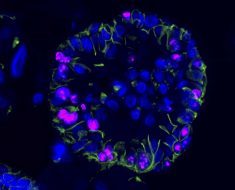In a recent study published in Micromachines, researchers assessed the efficiency of a genetic decoding system for diagnosing non-small cell lung cancer (NSCLC).

Background
NSCLC is one of the leading causes of cancer-related mortality worldwide. Targeting the gene mutation-induced sensitization of the epidermal growth factor receptor (EGFR) with a tyrosine kinase inhibitor has proven to be an effective treatment for NSCLC. Therefore, the tailored therapeutic strategy has emphasized the need for simple, rapid, and intelligent technologies for the genetic decoding of EGFR to facilitate the popularity of precision medicine.
About the study
In the present study, researchers combined loop-mediated isothermal amplification (LAMP) and amplification refractory mutation system (ARMS) to yield OnePot-LAMP, a simple, rapid, and inexpensive method for intelligent EGFR decoding.
The team developed two primer sets intended for EGFR L858R decoding to produce One-Pot-LAMP. Mutant and wild-type variants are abbreviated "M" and "WT" respectively, for simplicity in this study. The M primer set consists of two M inner primers and two outer primers for identifying the mutant variant. The WT primer set consists of two inner and two outer primers for identifying the wild-type variant. Additionally, two primers for plasmid synthesis and deoxyribonucleic acid (DNA) sequencing were created.
Two plasmids harboring the EGFR sequences of either the WT or the L858R mutation were produced. The recovered recombinant plasmids were then converted into Escherichia coli DH5ɑ cells before extraction. All plasmids were validated by DNA sequencing, and their quantities were calculated. The team obtained two lung cancer cell lines carrying the L858R point mutation (NCI-H1975) and the WT variant (A549) of EGFR as positive and negative samples, respectively.
A total of 40 individuals diagnosed with NSCLC underwent malignant tissue resection. For the subsequent study, all malignant tissues were fixed with formalin and embedded with paraffin. The genomic DNA was isolated from cell lines, and the malignant tissue was extracted. When EGFR L858R decoding utilizes this approach, two parallel amplification processes are performed simultaneously for each specimen by identifying the M and WT variants.
Results
Cancer Research eBook

To decode the EGFR L858R mutation, two inner primers were designed to recognize the target variant based on their DNA sequences. The L858R point mutation nucleotide was placed between the B1c and F1 regions, with the two regions overlapping in this mutation. Thus, the critical nucleotide of the primer set associated with EGFR L858R decoding was constructed at the 50-terminus located in the inner primer.
Two simultaneous LAMP assays were used to ascertain the mutant status of the L858R mutation in the EGFR. Particularly, double-stem-loop structures were generated by displacing strands in the reaction mixtures and functioned as the catalyst for self-primed DNA synthesis. The team noted that a double-stem-loop structure consisting of complementary nucleobases to the target variant would emerge in the matched primer-variant tube. In turn, leading to exponential DNA amplification along with the buildup of stem-loop DNA with varying stem lengths.
In the mismatched primer-variant tube, a double stem-loop structure comprising a non-complementary nucleobase would emerge, preventing self-priming DNA synthesis. Thus, the S-shaped amplification kinetic curve obtained from the exponential amplification of DNA would only be visible if the specimen had the variant matched to the primer set.
The M variant resulted in a large signal amplification in the M tube, whereas the WT variant resulted in amplification exclusively in the WT tube. Relative to the mismatched primer-variant pair, the team observed that matched primer-variant pairs generated a large S-shaped amplification kinetic curve, facilitating the determination of the EGFR mutation status. Considering the negative control, the amplification kinetic curves for the M and the WT tubes were consistent with those noted for the mismatched primer-variant pair.
The performance of One-Pot-LAMP was assessed under ideal conditions, and plasmids were used as a sequence control standard. The total plasmid mixture was used in the reaction mixture to assess the method's ability to identify the target variant in the presence of an interferential background.
Even when the target plasmid concentration was approximately 0.1%, remarkable S-shaped amplification kinetic curves were found for all test samples containing the target variant within 40 minutes. However, there was no amplification signal for the plasmid mixture that contained no target variant, demonstrating the excellent sensitivity as well as specificity of this approach.
Conclusion
The study findings showed that One-Pot-LAMP provided great sensitivity and specificity while also being easily adapted for the decoding of additional genetic information by re-designing the primer sets. Using real-world data, the performance of One-Pot-LAMP to detect the EGFR L858R mutation was validated, indicating the significant promise of this uncomplicated method for NSCLC diagnosis in clinical practice.
- Liu, X., Zhang, J. and Hua, K. (2023) "Intelligent Genetic Decoding System Based on Nucleic Acid Isothermal Amplification for Non-Small Cell Lung Cancer Diagnosis", Micromachines, 14(3), p. 647. doi: 10.3390/mi14030647. https://www.mdpi.com/2072-666X/14/3/647
Posted in: Medical Science News | Medical Research News | Disease/Infection News
Tags: Cancer, Cancer Diagnosis, Catalyst, Cell, DNA, DNA Sequencing, DNA Synthesis, Gene, Genetic, Genetic Information, Genomic, Growth Factor, Kinase, Kinase Inhibitor, Lung Cancer, Malignant, Medicine, Mortality, Mutation, Non-Small Cell Lung Cancer, Nucleic Acid, Nucleobase, Nucleotide, Plasmid, Point mutation, Precision Medicine, Receptor, Small Cell Lung Cancer, Tyrosine

Written by
Bhavana Kunkalikar
Bhavana Kunkalikar is a medical writer based in Goa, India. Her academic background is in Pharmaceutical sciences and she holds a Bachelor's degree in Pharmacy. Her educational background allowed her to foster an interest in anatomical and physiological sciences. Her college project work based on ‘The manifestations and causes of sickle cell anemia’ formed the stepping stone to a life-long fascination with human pathophysiology.
Source: Read Full Article





